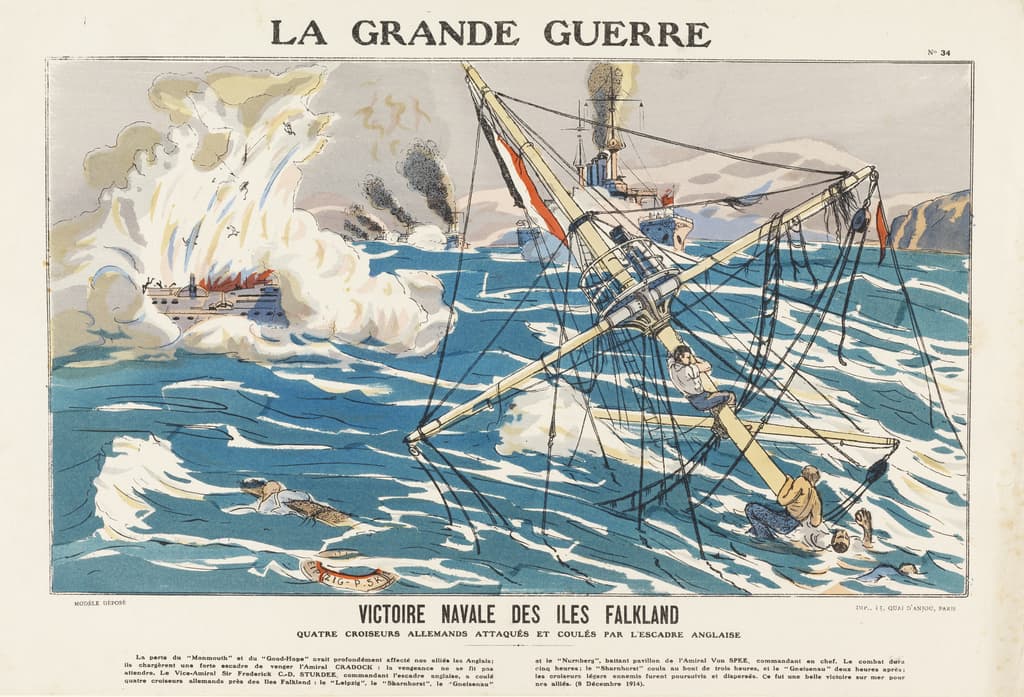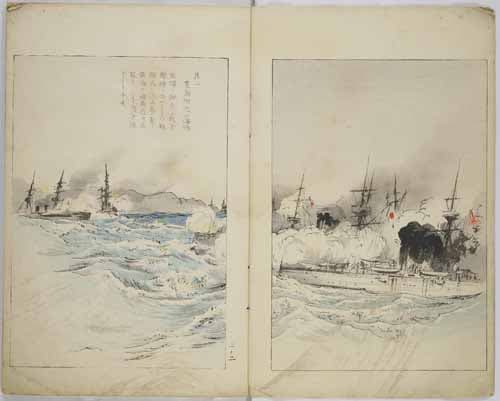
Unknown printmaker
Victoire navale des îles Falkland …
Falkland Islands naval victory. Four German cruisers attacked and sunk…
Lithograph with hand colouring through stencils. Publisher: Tolmer & Co. December 1914
Given by Sophie Gurney 1994
No. 34 from the series La Grande Guerre
P.35-1994
The Battle of the Falkland Islands took place on 8 December 1914 and was a success for Britain, effectively ending German naval presence on the high seas. However it came about in reaction to a significant British defeat by the Germans, which had inflicted damage to Britain’s reputation. At the Battle of Coronel on 1 November, Rear-Admiral Sir Christopher Cradock and his crew of 1,600 were killed off the coast of central Chile by five German cruisers led by Admiral Maximilian von Spee. This earlier battle is alluded to in the print’s caption, but not fully explained, showing that the publishers assumed the audience would be up-to-date with current affairs. Only one of the four cruisers - the Dresden - escaped, although this too was sunk in March 1915.
Compare this ocean scene to no. 23 of the series, executed by a different artist. In the earlier print the artist makes more use of the printing ink over the surface of the lithographic stone to create a hazy atmosphere, the air full of vapour. Here, the artist relies heavily on the application of colour to delineate form and the choppy water. It is very possible that the artist was influenced by depictions of naval battles of the First Sino-Japanese war (1894-95), such as this one illustrated below, from a volume of the printed book Nisshin senso emaki (‘Picture book of the Sino-Japanese war’), Vol. 2 of 10, Suzuki Kason, 1895, Tokyo.

The caption reads: ‘The naval battle of the Asian Sea - where Chinese warships Chi-yuen, Tsao-kiang, Kwong-yih, with Kau Shing a transport vessel, carrying armes soliders on board them, met with Japanese cruisers ‘Yoshino’ ‘Naniwa’ and Akitsushima’ who were cruising along there on the 25th July ayt 7 AM. Chinese ships made hostility suddenly against Japanese ships, Chi-Yuen and Kwong-Yih flied away after having fired guns against Japanese.’
Ebi collection. Ritsumeikan university Art Research centre Books database. Ebi0491
The French caption with English translation:
VICTOIRE NAVALE DES ILES FALKLAND. QUATRE CROISEURS ALLEMANDS ATTAQUÉS ET COULÉS PAR L’ESCADRE ANGLAISE.
La perte du “Monmouth” et du “Good-Hope” avait profondément affecté nos alliés les Anglais; ils chargèrent une forte escadre de venger l’Amiral CRADDOCK : la vengenace ne se fit pas attendre. Le Vice-Admiral Sir Frederick C.D. STURDEE, commandant l’escadre anglaise, a coulé quatre croiseurs allemande près des Iles Falkland : le “Leipzig”, le “Sharnhorst”, le “Gneisenau” et le “Nurmberg”, battent pavillon de l’Admiral Von SPEE, commandant en chef. Le combat dura cinq heures : le “Sharnhorst” coula au bout de trois heures, et le “Gneisenau” deux heures après : les croiseurs légers ennemis furent poursuivis et dispersées, Ce fut une belle victoire sur mer pour nos alliés. (8 Décembre 1914)
Falkland Islands naval victory. Four German cruisers attacked and sunk by the British fleet
Our English Allies had been deeply affected by the loss of the ‘Monmouth’ and ‘Good Hope’. They sent a strong fleet to avenge Admiral Cradock. Vengeance was not kept waiting. The Vice-Admiral Sir Frederick C.D. Sturdee, commanding the British fleet, sank four German cruisers near the Falkland islands: the ‘Liepzig’, ‘Scharnhorst’, ‘Gneisneau’ and ‘Nirmberg,’sailing under chief commander Admiral Von Spee. The battle lasted five hours: the ‘Scharnhorst’ sank after three hours and the ‘Gneisenau’ two hours later: the light enemy cruisers were pursued and dispersed. It was a great sea victory for our Allies. (8 December 1914).




